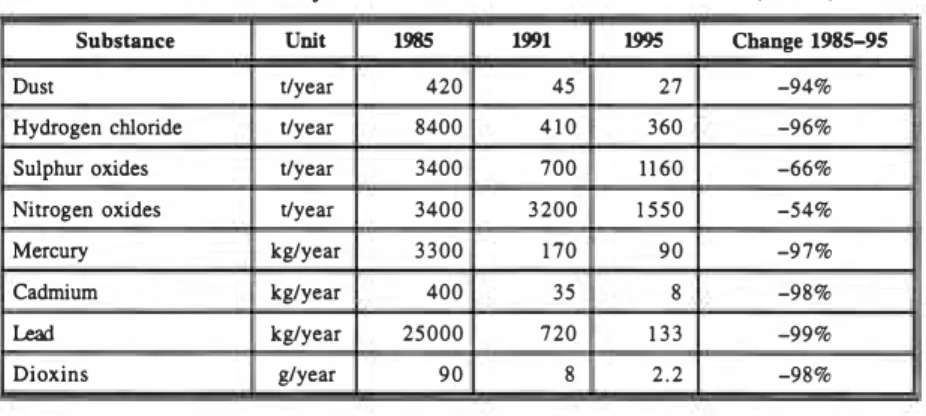WASTE MANAGEMENT AND THE ENVIRONMENT KALMAR, SWEDEN, November 5-7, 1997
19
WASTE INCINERATION IN
SWEDEN - PAST AND FUTURE
Kjerstin Ekwall SYSA V Utveckling AB SwedenSUMMARY
Today there are 21 energy-from-waste plants with a total of 39 incinerators in operation in Sweden. Statistics for 1995 show that a total of more than 1.8 mil lion tonnes of waste were combusted, and the energy produced amounted to 5.0 TWh (see diagram below).
D
Waste (Mt)■
Energy (TWh)5
1980 1983 1986 1991 1994 1995
Diagram 1. Quantities of waste incinerated and energy produced at Swedish waste incineration plants in the period 1980-1995.
The quantity of combusted waste has more than doubled since 1980, and energy production during the same period has almost quadrupled. This is because the
Kjerstln Ekwall, Sweden 165
45
35
WASTE MANAGEMENT AND THE ENVIRONMENT KALMAR, SWEDEN, November 5-7, 1997
waste has become more energy-rich, but above all it is because energy recovery is more efficient and the proportion of energy lost by cooling has been reduced. Initially the plants were equipped only with a cyclone or electrofilter for cleaning of dust-bound pollutants in the flue gases. Because of stricter environmental requirements, all the plants have been supplemented with advanced cleaning sys tems which also remove gaseous pollutants from the flue gases. For plant-specific flue-gas cleaning equipment see table 3.2, chapter 3.
A total of 12 plants have also taken measures to reduce NO, emissions. Three plants have installed flue-gas recycling, five plants have installed SNCR, and four plants have combined SNCR and flue-gas recycling.
The investments in advanced flue-gas purification systems and equipment for re� duction of NO, have resulted in heavily reduced emissions from the waste incine ration plants (see table 1).
Table 1. Annual emissions from waste incineration in Sweden 1985, 1991, 1995.
Substance Unit 1985 1991 1995 Change 1985-95
Dust t/year 420 27 -94%
Hydrogen chloride t/year 8400 4 10 360 -96%
Sulphur oxides t/year 3400 700 1160 -66%
Nitrogen oxides t/year 3400 3200 1550 -54%
Mercury kg/year 3300 170 90 -97%
Cadmium kg/year 400 8 -98%
Lead kg/year 25000 720 133 -99%
Dioxins g/year 90 8 2.2 -98%
In 1986, 1.53 million tonnes of waste were incinerated, and energy production amounted to 3.4 TWh. In 1995, 1.81 million tonnes of waste were incinerated and energy production was 5.0 TWh. The last ten-year period of Swedish waste incineration can thus be summed up as follows: Increased quantity of incinerated waste per year (+18%), significantly higher energy production (+47%), and gre atly reduced emissions (-54 to -99%).
In environmental terms, energy production from waste is fully comparable to (and in some cases better than) conventional energy production with e.g. oil, co al, and gas. The waste can mostly be classified as bio-fuel, and the energy from the waste can be used efficiently in the Swedish district heating networks. The view of energy production from waste differs from country to country, however. The EU Commission is working today to draw up new guidelines for the incineration of waste. The working material that has been presented shows that the emission criteria will be much stricter and that they are not at all in
pro-Kjerstln Ekwall, Sweden 166
WASTE MANAGEMENT AND THE ENVIRONMENT KALMAR, SWEDEN, November 5-7, 1997

